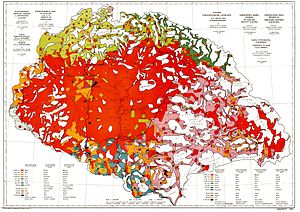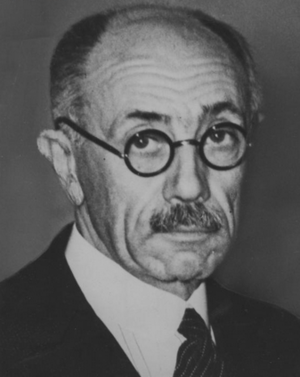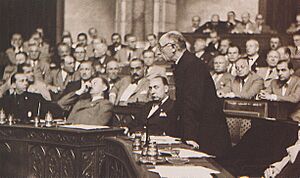Pál Teleki facts for kids
Quick facts for kids
Pál Teleki
|
|
|---|---|
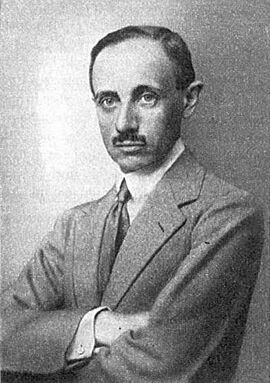
Teleki as prime minister
|
|
| Prime Minister of Hungary | |
| In office 16 February 1939 – 3 April 1941 |
|
| Regent | Miklós Horthy |
| Preceded by | Béla Imrédy |
| Succeeded by | László Bárdossy |
| In office 19 July 1920 – 14 April 1921 |
|
| Regent | Miklós Horthy |
| Preceded by | Sándor Simonyi-Semadam |
| Succeeded by | István Bethlen |
| Minister of Religion and Education | |
| In office 14 May 1938 – 16 February 1939 |
|
| Prime Minister | Béla Imrédy |
| Preceded by | Bálint Hóman |
| Succeeded by | Bálint Hóman |
| Personal details | |
| Born | 1 November 1879 Budapest, Pest-Pilis-Solt-Kiskun County, Kingdom of Hungary |
| Died | 3 April 1941 (aged 61) Budapest, Hungary |
| Political party |
|
| Spouse | Countess Johanna von Bissingen-Nippenburg |
| Children | 2, including Géza Teleki |
| Signature | |
Count Pál János Ede Teleki de Szék (born November 1, 1879 – died April 3, 1941) was an important Hungarian politician. He served as the Prime Minister of the Kingdom of Hungary two times. His first term was from 1920 to 1921, and his second was from 1939 to 1941.
Teleki was also a geography expert and a university professor. He was a member of the Hungarian Academy of Sciences. He was also the chief scout for the Hungarian Scout Association. His family was a noble family from Transylvania.
During the early part of World War II, Teleki tried to keep Hungary neutral. However, he also worked with Nazi Germany to get back Hungarian land lost after World War I. Teleki died when German troops entered Hungary on their way to invade Yugoslavia. This ended Hungary's hopes of staying neutral.
He is a debated figure in Hungarian history. As prime minister, he tried to protect Hungary's independence during very tough political times. But he also supported and passed laws that were unfair to Jewish people.
Contents
Early Life and Education
Pál Teleki was born in Budapest, Hungary. His father, Géza Teleki, was a Hungarian politician. His mother, Irén Muráty, came from a wealthy Greek family.
Teleki went to school in Budapest. He studied law and political science at Budapest University. He also studied at the Royal Hungarian Academy of Economy. He earned his PhD in 1903. Later, he became a university professor. He was known as an expert in geography and social studies. He also fought as a volunteer in the First World War.
In 1918 and 1919, Teleki created a famous map. It showed the different ethnic groups in Hungary. This map, called the Red Map, was used during the peace talks for the Treaty of Trianon. His maps were very good at combining social and geographic information. From 1910 to 1923, he was the Secretary General of the Geographical Society. He also represented Hungary at the Versailles Peace Conference in 1919.
Teleki and Scouting
Teleki became very involved in Scouting. This happened after his son, Géza, had an experience at a Sea Scout rally in Denmark in 1927. Géza's Scoutmaster, Fritz M. de Molnár, told Teleki that his son thought Teleki wasn't interested in Scouting. This made Molnár want to talk to Teleki about it.
Molnár's talk made Teleki very interested in Scouting. He became Hungary's Chief Scout. He was also a member of the International Scout Committee from 1929 to 1939. Teleki was the Camp Chief for the 4th World Scout Jamboree. This big event was held in Gödöllő, Hungary. He became good friends with Robert Baden-Powell, 1st Baron Baden-Powell, who started the Scouting movement. Teleki's support helped Scouting become very popular in Hungary.
Political Career and World War II
Protecting Hungary's Independence
Some people see Teleki as a hero. They believe he tried to keep Hungary out of World War II. He even sent a politician, Tibor Eckhardt, to the United States with money. The idea was to prepare a Hungarian government that could operate from outside the country. This was in case he and Regent Miklós Horthy had to leave. His goal was to save Hungary's independence under pressure from Nazi Germany. He hoped Hungary could survive the war like the Polish government in exile.
Hungary's "Non-Belligerent" Status
Teleki became Minister of Education in 1938. He supported Germany taking over Czechoslovakia. He hoped this would help Hungary get back land lost in the 1920 Treaty of Trianon. On February 16, 1939, Teleki became Prime Minister for the second time. He tried to close down some fascist political parties. However, he did not end the existing laws that were unfair to Jewish people.
On September 1, 1939, Germany invaded Poland. Germany asked to use Hungarian railways to attack Poland from the south. Hungary had strong ties with Poland. Teleki refused Germany's request. Regent Horthy told the German ambassador that he would rather destroy the railway lines than help attack Poland. Hungary declared itself a "non-belligerent" nation. This meant they would not take part in the war.
Because Teleki refused to help Germany, many Polish people escaped into Hungary. Over 100,000 Polish soldiers and hundreds of thousands of civilians, including many Jewish people, crossed the border. The Hungarian government allowed Polish aid groups to help them. Most Polish soldiers later managed to escape to France.
However, Germany had taken over Austria, Czechoslovakia, and Poland. This meant there were no longer countries separating Hungary from Germany and the Soviet Union. Germany then demanded that Hungary help their war effort.
Germany Demands Hungary's Help
In 1940, Germany wanted to occupy Romanian oil fields. They asked Hungary for permission for their troops to pass through. Germany offered to give Hungary back part of Transylvania if they helped. Hungary wanted to stay neutral. However, Teleki allowed German troops to cross Hungarian land into southern Romania. In return, Hungary got back a large part of Transylvania in August 1940. In November, Teleki's government signed the Tripartite Pact. This agreement connected Hungary with Germany, Italy, and Japan.
In March 1941, Teleki strongly disagreed with Hungary joining the invasion of Yugoslavia. Hungary's resistance made Germany distrust them. Hungary was not told about Hitler's secret plans to invade the Soviet Union. Germany did not initially see Hungary as a full ally.
Teleki believed that a group of Central and Eastern European countries could unite. This "Danubian Federation" would help them avoid being controlled by Germany. He sent a secret message to contacts in America. He hoped they would help these countries form a federal system. He believed this would give them security and economic success. Teleki said Hungary was ready to join such a group. But he received no response to his ideas.
A Difficult Choice
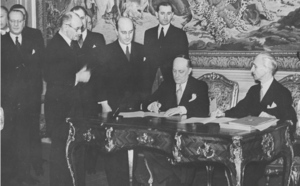
On March 25, 1941, Yugoslavia signed the Tripartite Pact. But soon after, Yugoslav military leaders took control of the government. They rejected the pact. Germany saw this as a threat. Germany then planned to invade Yugoslavia. Hitler demanded that Hungary join the invasion.
Teleki had signed a peace agreement, the Treaty of Eternal Friendship, with Yugoslavia just five months earlier. He did not want to help with the invasion. His government decided to stay out of the conflict. They would only get involved if Hungarian people were in danger or if Yugoslavia fell apart. Teleki told London about Hungary's difficult situation.
On April 3, 1941, Teleki received a message from London. The British Foreign Secretary threatened to end relations with Hungary if it did not stop German troops. He also threatened war if Hungary attacked Yugoslavia.
Teleki wanted Hungary to remain neutral. But he could not ignore Germany's power. He faced a terrible choice. He could keep resisting Germany, which might lead to Germany invading Hungary next. Or he could allow German troops to cross Hungary, betraying Yugoslavia and leading to war with the Allies.
Regent Horthy, who had also resisted Germany, agreed to Germany's demands. Teleki met with his cabinet that evening. He was upset that Horthy had changed his mind.
Before Teleki could decide, the Hungarian General Staff chief, General Henrik Werth, acted without government approval. Werth made private plans with Germany for troops to cross Hungary. Teleki called this action treason.
Teleki's Legacy
Laws Affecting Jewish People
Teleki is seen as a politician who was very strict about laws affecting Jewish people after World War I.
When he became Prime Minister in 1920, he introduced the "Numerus clausus Act." This law limited the number of Jewish students allowed in universities. It said that Jewish students could only attend in proportion to their number in the Hungarian population. Teleki and his government resigned less than a year later.
After World War I, many Jewish people in Hungary were part of the middle class. They worked as doctors, journalists, and lawyers. They also controlled a large part of the country's banks and industries. After a period of economic problems, Jewish people were sometimes blamed for Hungary's difficulties.
When Teleki became Prime Minister again in 1939, he supported a new law. This was the Second Anti-Jewish Act. This law defined "Jew" based on race. It stopped Jewish people from holding government jobs or working as editors, publishers, or directors. It also limited the number of Jewish employees in businesses. These laws affected hundreds of thousands of Jewish people.
Teleki also signed a law in 1939 that made all young Jewish men join forced-labor service. This was later extended to all able-bodied Jewish men. As a result of these laws, many Jewish people were deported. Some were sent to areas where they were later killed by the Nazis.
Teleki wrote the introduction to the Second Anti-Jewish Law. He also prepared the Third Anti-Jewish Law in 1940. He signed many other decrees against Jewish people during his time in office.
The forced labor system became much harsher after Hungary entered the war. Jewish forced laborers were put into special groups. They had to do war-related construction work. They often faced extreme cold, little shelter, not enough food, and poor medical care. Tens of thousands of Jewish forced laborers died before Germany occupied Hungary in 1944. After that, many more Jewish people were sent to death camps.
While many young Hungarians were also forced into military service and sent to fight, their suffering was due to the war itself. The suffering of Jewish labor battalions was deliberately caused by the laws and conditions they faced.
Images for kids
See also
 In Spanish: Pablo Teleki para niños
In Spanish: Pablo Teleki para niños
- László Almásy
- Hungarian Turanism
- Hungary–Yugoslavia relations


